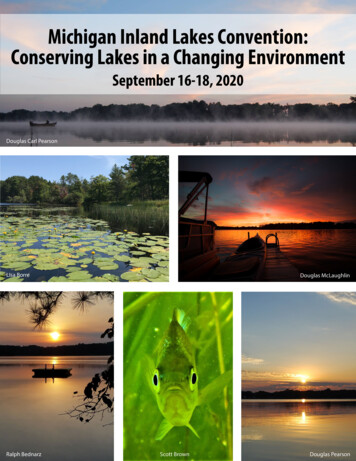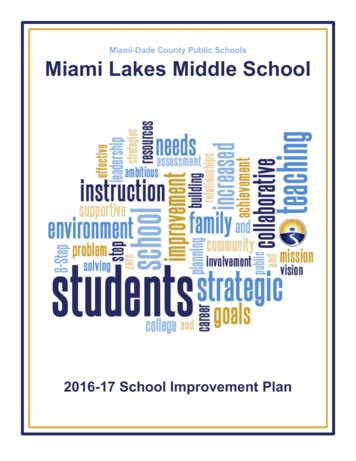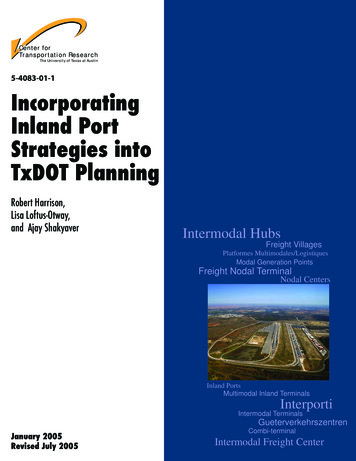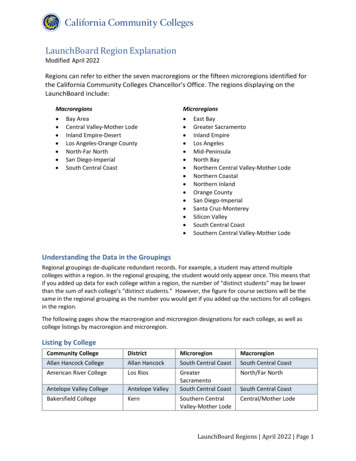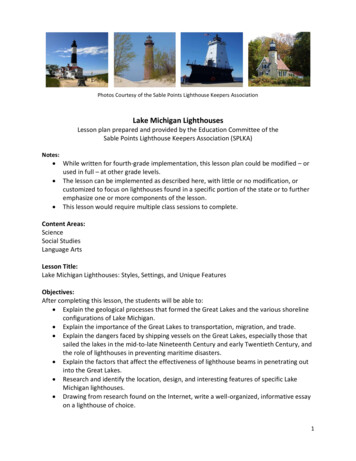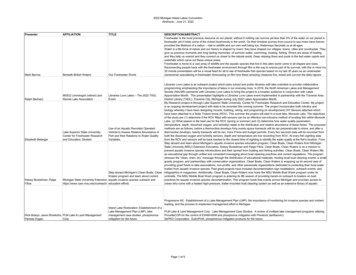
Transcription
2022 Michigan Inland Lakes ConventionAbstracts - June 21, 2022PresenterAFFILIATIONTITLEMark BarrowBeneath British WatersOur Freshwater WorldRalph BednarzElizabeth BelangerKelsey Bockelman, PaigeFiliceDESCRIPTION/ABSTRACTFreshwater is the most precious resource on our planet, without it nothing can survive yet less than 4% of the water on our planet isfreshwater yet it holds some of the richest biodiversity in the world. On their timeless journey from source to sea rivers have foreverprovided the lifeblood of a nation – vital to wildlife and our own well being too. Waterways fascinate us at all ages.Water is a life-force of nature and our history is shaped by rivers: they have shaped our villages, towns, cities and countryside. Theygive us precious moments and long lasting memories: of summer walks, swimming, boating, fishing. Rivers are areas of healingand they help us unwind and they connect us closer to the natural world, Deep relaxing flows and pools to the fast water rapids andwaterfalls which carve out these unique areas.Freshwater is home to a vast array of wildlife and the aquatic species that live in this alien world come in all shapes and sizes.Reconnecting people back with the freshwater environment through film is the way to ensure part of its survival, with this in mind my30 minute presentation will be a visual feast for all to see of freshwater fish species based on my last 30 years as an underwatercameraman specialising in freshwater showcasing on film how these amazing creatures live, breed and survive the daily rigoursLibraries Love Lakes is an outreach project which pairs school and public libraries with lake scientists to provide collaborativeprogramming emphasizing the importance of lakes in our everyday lives. In 2019, the North American Lakes and ManagementSociety (NALMS) partnered with Libraries Love Lakes to bring the project to a broader audience in conjunction with LakesMDEQ Limnologist (retired) andLibraries Love Lakes – The 2022 TADLAppreciation Month. This presentation highlights a Libraries Love Lakes event implemented in partnership with the Traverse AreaRennie Lake AssociationEventDistrict Library (TADL), Traverse City, Michigan during July 2022 Lakes Appreciation Month.My Research project is through Lake Superior State University, Center for Freshwater Research and Education Center. My projectis an ongoing development project with data to be recorded this coming summer. The project incorporates both robotics andbiology whereby I have been designing mounts, building, wiring, and programing (in development) DIY Sensors attached whichhave been attached to a Sofar Trident drone (ROV). This summer the project will start in a local lake, Monocle Lake. The objectivesof the study are (1) determine if the ROV fitted with sensors can be an effective non-intrusive method of locating fish within MonocleLake, (2) What season is the best use for the ROV (spring or summer) and (3) determine how water quality parameters(temperature, depth, dissolved oxygen, and turbidity) relate to the distribution and relative abundance of these fishes. The proposedUse of an Aquatic Remotely Operatedmethods are as follows; before a thermocline develops forty evenly space transects will be ran perpendicular to shore, and after aVehicle to Assess Relative Abundance ofLake Superior State University;thermocline develops, twenty transects will be ran, more if time and budget permits. Every two seconds data will be recorded fromFish and their Relations to Water QualityCenter for Freshwater Researchboth the dissolved oxygen and turbidity sensors, depth and temperature are live recording from ROV. At every fish sighting dataVariables.and Education; Studentfrom the ROV and sensors will be back tracked to the closest time of sighting to identify the water quality at the fish's location. FromStep aboard and learn about Michigan’s aquatic invasive species education program, Clean Boats, Clean Waters from MichiganState University (MSU) Extension Educators, Kelsey Bockelman and Paige Filice. Clean Boats, Clean Waters is on a mission toprevent aquatic invasive species introductions and their spread from boating and fishing activities. Clean Boats, Clean Waters fillsan educational gap through unified and consistent messaging about boat cleaning practices and current regulations. The programstresses the “clean, drain, dry” message through the distribution of educational materials, hosting local boat cleaning events, a smallgrants program, and partnerships with conservation organizations. Clean Boats, Clean Waters is wrapping up its second year ofproviding grant funds to lake associations, non-profits, and other passionate organizations dedicated to protecting their local waterbodies from aquatic invasive species. Past grant projects have included decontamination sign installations, outreach events, andStep aboard Michigan's Clean Boats, Clean infographics in magazines. Additionally, Clean Boats, Clean Waters now hosts the MSU Mobile Boat Wash program under itsWaters program and learn about currentumbrella. The MSU Mobile Boat Wash program is entering its 8th season of providing hands-on outreach to boaters on bestMichigan State University Extension: aquatic invasive species outreach andpractices for aquatic invasive species decontamination. This program hosts free events across Michigan and provides access tohttps://www.canr.msu.edu/outreach/ education effortscrews who come with a heated high-pressure, trailer-mounted boat cleaning system as well as an extensive library of aquaticProgressive AE: Establishment of a Lake Management Plan (LMP); the importance of monitoring for invasive species and nutrientloading, and the process to implement management effort in Michigan.Rick Buteyn, Jason Broekstra, PLM Lake & Land ManagementPamela DuganCorpInland Lake Restoration; Establishment of aPLM Lake & Land Management Corp: Lake Management Case Studies; A review of multiple lake management programs utilizingLake Management Plan (LMP), lakeProcellaCOR for the control of EWM/HWM and phosphorus mitigation with Phoslock (lanthanum).management case studies, phosphorousSePRO Corporation: EutroPHIX, phosphorous mitigation products for the future.mitigation for the future.Page 1 of 9
2022 Michigan Inland Lakes ConventionAbstracts - June 21, 2022PresenterAFFILIATIONRalph Bednarz, Frank Lupi,Alan Steinman, Ron Olson,Scott BrownMichigan Waterfront AllianceEric CalabroEGLE WRDEric CalabroEGLE WRDTITLEDESCRIPTION/ABSTRACT“Michigan Lakes: What are the Numbers” - Ralph Bednarz, MDEQ MiCorps Manager (retired); Rennie Lake AssociationMichigan’s landscape is home to more than 11,000 inland lakes, and Michigan’s boundaries are shaped by four of the fiveLaurentian Great Lakes with over 3,000 miles of shoreline. These lakes and shorelines are critical resources to Michigan’senvironment and quality of life, providing sources of drinking water, irrigation, energy, commerce, recreation, scenic beauty andhabitat for fish and wildlife. This presentation introduces and highlights Michigan’s inland lake resources through a number of lensand sets the stage for the “Economic Contributions of Michigan’s Inland Lakes” presentations that follow.“Economic Value of Recreational Fishing on Michigan’s Inland Lakes” - Dr. Frank Lupi, Professor, Michigan State University Dept.of Agriculture, Food, and Resource Economics & Dept. of Fisheries and WildlifeMichigan’s robust recreational fishing community is enabled by the existence of 11,037 inland lakes of five acres or more whoseaquatic ecosystems provide optimal habitat to 153 freshwater fish species, including several extraordinarily popular species such aslargemouth bass, smallmouth bass, bluegill, red ear sunfish, crappie, yellow perch, walleye, and northern pike. Supported by overone million enthusiastic participants that purchase Michigan Department of Natural Resources mandated fishing licenses, and thaton average spend well over one thousand dollars annually on their favorite outdoor pastime, Michigan’s inland lake-enabledrecreational fishing community make a significant contribution to Michigan’s economy. This presentation will provide viewers with abroad qualitative and quantitative overview of the multi-faceted contributions of inland lake-based recreational fishing to Michigan’sdiverse economy.“Social and Economic Benefits of Shoreline Restoration: Muskegon Lake as a Case Study” - Dr. Alan D. Steinman, Professor,GVSU; Director, Annis Water Research InstituteMuskegon Lake (MI) is a designated Great Lakes Area of Concern with a long history of environmental abuse. Following thecollapse of the lumber industry, foundries and factories rimmed the lake, leaving a legacy of marine debris, sediment contamination,excess nutrients, and degraded habitat. A series of restoration efforts that have occurred over the course of the past thirty years thathave been initiated by an active and engaged group of stakeholders, has resulted in a 30-year period of remediation andrestoration. This presentation will review the history of Muskegon Lake uses and discuss the specific economic benefits and socialattitudes associated with the changes in Muskegon Lake based on recent socio-economic studies.“The Economic Value of Michigan’s Inland Lakes: A Literature Review” - Scott Brown, MWA / McNALMSComprising 1,300 square miles, or just 1.3% of our state’s total landscape area, the existence of 62,798 inland lakes contributedisproportionately to defining, supporting, and sustaining Michigan’s increasingly diverse, world-class economy. Gracing ourlandscape like sparkling jewels, the priceless freshwater creations of the last ice age provide near unlimited high quality recreationalopportunities for hundreds of thousands of our citizens and visitors to our magnificent state as well as economic opportunity forAn Assessment of the Economichundreds of thousands of Michigan residents. The near shore areas of many of our inland lakes also provide premium lakefrontContributions of Michigan's Inland Lakesliving opportunities that support enhanced residential property values that benefit hundreds of Michigan townships and publicVarious aquatic plant control activities are regulated under different statutes on Michigan’s inland lakes. Physical/mechanical controlof aquatic plants is regulated under Part 301, Inland Lakes and Streams and Part 303, Wetlands Protection of the NaturalResources and Environmental Protection Act, 1994, PA 451, as amended (NREPA), and administered through EGLE’s Wetlands,Lakes, and Streams Program. Chemical control of aquatic plants is regulated under Part 33, Aquatic Nuisance Control of thePolicy and Regulation surrounding Aquatic NREPA and administered through EGLE’s Aquatic Nuisance Control Program. This session will cover best management practicesPlant Management in Michiganand permitting requirements for various types of aquatic plant control methods.Certain construction activities such as dredging, adding fill, or placing structures on bottomlands in waterbodies and wetlands ofMichigan may be regulated under the Natural Resources and Environmental Protection Act, 1994, PA 451, as amended (NREPA).State Regulations Surrounding Construction Part 301, Inland Lakes and Streams and Part 303, Wetlands Protection of the NREPA are two of the statutes regulating manyActivities on Wetlands, Lakes, and Streams construction activities on Michigan’s wetlands, lakes, and streams. This session will cover best management practices andThis session will discuss statewide National Lake Assessment trends with a focus on the inland lake shoreline development metrics.We will also present multiple case studies from around Michigan which used GIS to quantify shoreline development through time,and provide the methods for lake associations to complete these analyses for their lakes. We will close this session with adiscussion of some best management practices for inland lake shorelines.Eric CalabroEGLE WRDInland Lake Shoreline Trends and AnalysisPage 2 of 9
2022 Michigan Inland Lakes ConventionAbstracts - June 21, 2022PresenterAFFILIATIONDane and William CareyCarey and Jaskowski PLLC andKuhn Rodgers PLCEmily CookBenzie ConservationDistrict/Aquatic Invasive SpeciesPathways ProgramTITLEDESCRIPTION/ABSTRACTThe firms of Carey and Jaskowski PLLC (William Carey) and Kuhn Rodgers PLC (Dane Carey) will host a question and answersession on current legal issues impacting inland lakes in Michigan. The scope of the legal questions would not be limited, beyondthe focus on inland lakes. However prominent current legal issues would include keyholing, commercial development of lakes viaCurrent legal issues impacting inland lakes development of lake channels, and judicial overview of the EGLE permitting process. Both speakers have extensive experience onall legal issues impacting inland lakes in Michigan and have presented similar question and answer sessions on these topics in thein MichiganNow in its sixth year of operation, the Aquatic Invasive Species Pathways Program (AISPP), has established itself as a one-of-a-kindpresence in northwest Michigan. Utilizing mobile boat washing units and passive education techniques, staff and volunteers areworking to encourage behavior change among watercraft users of all kinds.With a goal of providing decontamination services to prevent the spread of invasive species, the AISPP travels throughout its fourcounty service area of Benzie, Grand Traverse, Manistee, and Leelanau counties. Working closely with a vast network of partnerswhich includes private community members, Lake Associations, Municipalities, and more – the mobile boat wash education stationChanging Behavior Among Watercraftand washing services are providing frontline aid in preventing the spread of aquatic invasive species.Users in Northwest Michigan:Utilizing proper messaging, incentives, and methods of approach, the AISPP and its partners have found increasing positiveHow the Aquatic Invasive Species Pathways response when engaging with boaters on the proper methods of AIS decontamination. That being said, there are still numerousProgram is working to prevent the spread of challenges and roadblocks in regard to completing conservation work that depends directly on human response. These trials andAIS through outreach and boat washinglessons will be discussed as they relate to invasive species and preventing their spread. Additionally, future plans for the AISPP andservicesadaptations in response to boater behavior will be addressed. (AISPP is partially funded via the Michigan Invasive Species GrantWe view our water environment from differing times: the distant past, the fleeting present, and the far future. We cannot changethe past of yesterday. We think we can change the present of today. We hope we can change the future of tomorrow! During ourbrief existences we are faced by the omnipresent hazards of life which can be either ubiquitous, and relatively benign, or infrequent,but severe. We are faced with threats of natural and/or anthropogenic (artificial) “disasters" of varying degrees, both real andimagined.Some of us are fortunate enough to be riparians and littorians, living along streams and lakes. We set goals to have “A place bythe water”. We plan to enjoy our lives in peaceful coexistence with both the naturally created environment and our artificially builtenvironment.Our lakes and rivers, however, are subject to beneficial and detrimental changes pending reactive or preventative actions, tocontrol water level controdl, human dimensions, and watershed managementSome changes are intense for short durations, like sudden storms with whitecapped waves, or dam breachings followed byinundations causing significant damage downstream, Other changes are imperceptible over long durations ofmillennia, like glaciersforming lakes and altering landscapes.Stacy Leroy Daniels"Benzie Co. River improvementCo."Melissa DeSimoneMichigan Lakes and StreamsAssociationMichigan Lakes and StreamsAssociationEric EcklWater Words That Work, LLCErick ElginMSU ExtensionMelissa DeSimoneProtecting Our Lakes from Natural &Anthropogenic Disasters – Yesterday,Today, & TomorrowChanges in construction and operation of engineered structures and changes in human behavioral patterns are addressed asexamples of preventive strategies.References271. Engineered Structures in Early Michigan History, Hist. Soc, MI, 03/30/2012.275. Human Impacts upon Crystal Lake: Past, Present, and Future, MiCorps Conf. 10/30/2012.A discussion of the acronyms used in Michigan to refer to organizations and terms important to water conservation and issues forlakes and streams. Join this session for an overview of important partners throughout the state and also receive a resource withacronym definitions and links to the organizations they represent.Utilizing Partners: The Michigan AlphabetSoup5 minute lightning talk about Michigan Lakesand Streams AssociationI will describe our mission, programs, and history of the organization.Make a splash with your words and pictures! Relearn the language that everyday citizens use and become more confident andsuccessful with your outreach. This course provides unique insights into what words and pictures turn your audience on, and off.Part 1. The Perils of Preaching to the Choir. You will discover how to spot the signs of "preaching to the choir" and recognize whenyou are sending messages that miss the mark or antagonize your audience.Part 2. The Environmental Message Method, Steps 1-4. You will learn a proven step-by-step method to translate professionalcaliber information into messages for the general public.Water Words That WorkRestoration of native plant communities is a key requirement of a successful invasive species control program. In lakes, nativeaquatic plant recovery following aquatic invasive species control may be slow due to a lack of existing, viable propagules- the resultof years of suppression by the invading species. Although some native aquatic plants produce persistent propagules within the seedbank, many do not and the diversity of returning plants post-management may be low as a result. Therefore, active restoration ofmultiple native plant species may be needed to revive the plant community. We tested three aquatic plant restoration techniquesAquatic plant restoration post invasive(hand planted, stapled, and weighted burlap) using three native plant species (Illinois Pondweed, Sago Pondweed, and Chara spp.)in a pond where eradication efforts are underway for Yellow Floating Heart. Success of each technique will be measured byspecies controlPage 3 of 9
2022 Michigan Inland Lakes ConventionAbstracts - June 21, 2022PresenterAFFILIATIONTITLEErick Elgin, Bill Keiper, EricCalabro, Tom Alwin, SarahLeSageMSU ExtensionAquatic Plant Identification WorkshopErick Elgin, Jo Latimore, PaulSkawinskiMSU ExtensionUsing and Understanding Temperature/Dissolved Oxygen Data collected by theMiCorps Cooperative Lakes MonitoringProgram - 90 minute workshopPaige FiliceKeeping aquarium and garden pets andMichigan State University Extension plants out of Michigan’s inland lakesMike FosterKieser & Associates, LLCReducing management decision uncertaintywith lake circulation modelingKevin FrankMichigan State UniversityLawns and Lakes: Managing Lawns whilePreserving Water QualityJason Frenzel, Kate Laramie,Eric Diesing, Sam DavisHurton River Watershed CouncilKelsey FroelichSchool of Public Health, Universityof AlbertaChallenges, successes, and lessons learnedin surveying for the aquatic invasive species,European frog-bit, in an urban settingMonitoring enteric bacteria contamination ina freshwater watershed in Northern, MIusing qPCR and a community participatoryresearch framework.DESCRIPTION/ABSTRACTSubmersed aquatic plants are an important component of lake ecosystems and provide many beneficial services. Yet, aquaticplants are often identified simply as “cabbage” or “milfoil”, which overlooks the wonderful diversity present in Michigan’s lakes.Furthermore, aquatic invasive species can often be confused with native look-alikes, which may spur improper management actionsor inaction. This workshop will consist of a lecture covering aquatic plant identification 101 mixed with interactive identificationactivities. Participation in this workshop will help advance submersed aquatic plant identification skills and foster a growingTemperature and dissolved oxygen data is essential in understanding the ecology of lakes. The extent of fish habitat and what fishspecies is present is often dictated by the presence and amount of oxygen. The presence of dissolved oxygen is also important tothe nutrient cycling of lakes, specifically the internal loading of phosphorus. Michigan’s volunteer lake monitoring program, MiCorpsCooperative Lakes Monitoring Program, measures temperature/dissolved oxygen in lakes across the state. This long-term datasetcan be used to understand lakes further and help with current and future management. This workshop will consist of a lecturecovering the basics of temperature and oxygen stratification in lakes. We will also go through simple graphing activities andcalculations that will help individuals visualize and interpret Temp/Dissolved Oxygen profile data. We will be using data collected byMiCorps Cooperative Lakes Monitoring Program volunteers. Microsoft Excel will be used for this workshop’s activities.Other Authors: Paul Steen, Jo Latimore, Tamara Lipsey, Jean Roth, Melissa DeSimoneAquatic invasive species are a significant ecological and economical threat to the health of Michigan’s inland lakes. Sometimesthese non-native plants and animals are from aquariums and water gardens and are released by well-meaning hobbyists. Toaddress this issue, Michigan State University Extension educates retailers and hobbyists about safe handling and disposal practicesfor aquarium and water garden organisms through the research-based outreach program Reduce Invasive Pet and Plant Escapes(RIPPLE). Since RIPPLE began in 2015 over 140 pet stores, garden centers, hobbyist clubs, nature centers, zoos and schooldistricts have become RIPPLE partners. Partners receive free aquatic invasive species identification and reporting resources asHydrologic circulation models provide predictive capabilities for complex lake issues that can otherwise be very difficult to analyze.We utilized the AEM3D model to simulate select inland lake applications to analyze a variety of lake conditions for large-scalemanagement implications. As a three-dimensional model, AEM3D allows for simulation of both horizontal currents as well asvertical mixing. It also allows for the simulation of biogeochemical processes such as macrophyte and algal growth, as well asnutrient/metals interactions. These capabilities allowed K&A to analyze phenomena such as:* Tributary loading and nutrient plume transport in a 7,300-lake with a 10 year hydraulic residence time including: 1) ice formationtiming and under-ice nutrient plume movements; 2) temperature stratification magnitude, timing and impacts on sediment/watercolumn exchangeMichigan is a state with invaluable surface water assets. From the Great Lakes to inland lakes and streams, Michiganders takegreat pride and enjoyment in our natural waters. Bordering many of the lakes are homes and of course many homes have lawns thatare at the waters edge or perhaps separated by a beach or a vegetative buffer. There are many misconceptions about turfgrassmanagement and especially nutrient management and it’s impact on water quality. In this presentation I will discuss the two primarynutrients of interest, nitrogen and phosphorus. I will discuss nutrient sources, application timing, rates, and risk of leaching or runoff.European frog-bit was first discovered in Oakland County, Michigan in 2018- far from previously known infestations in the GreatLakes. This aquatic invasive plant negatively impacts local ecosystems and hinders recreational boat traffic. A grant was awarded tothe Oakland County CISMA from the State of Michigan to determine the extent of the infestation in the county and to increase publiceducation about this species. The CISMA is collaborating with local watershed councils (Huron River, Clinton River, & Friends of theRouge) to survey water bodies near the infestation, as well as to create educational materials, host virtual public meetings, and tomail information to landowners. Last year, watershed staff surveyed a total of 320 points (approximately 150 acres), only 23% ofwhich were private. No new frog-bit locations were found, and no aquatic watch-list species were observed. In 2022, surveying newsites and treating known frog-bit locations will be our main focus. This panel will review lessons learned during surveying andtreatment, as well as future steps and improvements including the use of mapping softwares (ArcGIS); coordinating with MI EGLEEnteric bacteria are a common and generally harmless part of the digestive system of all animals, including humans. Certainspecies of enteric bacteria are used as indicators of faecal pollution in water bodies. Traditionally, faecal contamination has beenmeasured using culturable Escherichia coli (E. coli), but newer techniques using quantitative polymerase chain reaction (qPCR)have proven to be advantageous to traditional methods due to the speed of processing and ability to undertake microbial sourcetracking studies on samples that are found to be highly contaminated. In this study, we assessed the presence and abundance ofthe faecal indicator bacteria Enterococcus at several locations along a river input to Crystal Lake, MI and at several beach locationsthat have historically presented high E. coli levels. Enterococcus qPCR values were compared to cultured E. coli values and eachsample was assessed for human (HF183) and gull (LeeGull) faecal markers to determine potential sources of contamination. Afterthe first year of data collection, qPCR results show a moderate correlation to culturable methods, while 10 out of the 11 sampledlocations showed evidence of human fecal contamination. Five out of the 11 sampled locations showed evidence of gull fecalcontamination. Analysis of these results, and other studies like it, can help lead management decisions for a lake and provideevidence to support septic system analysis. This project highlights the ability of community partners to participate in research andPage 4 of 9
2022 Michigan Inland Lakes ConventionAbstracts - June 21, 2022PresenterAFFILIATIONTITLEElizabeth HaberRare Aquatic Plant Species in Michigan: Anoverview of their Identification, HabitatMichigan Natural Features Inventory Preferences, and StatusPaul HauslerProgressive AEA review of the fishery response over time tocontinuous AIS management in severalMichigan lakesJennifer Jermalowicz-JonesRestorative Lake Sciences LLCDifferences in Rural and Urban Lakes andImplications for ManagementWilliam Keiper, SarahLeSage, Tom AlwinMI Dept. of Environment, GreatLakes, and EnergyProgress toward eradication of ParrotFeather and Yellow Floating Heart inMichiganWilliam KeiperJulia Kirkwood, Joe NohnerMI Dept. of Environment, GreatLakes, and EnergyEGLE WRDExpansion of European Frog-bit in Michigan:Response at Reeds and Fisk Lake CaseStudyGrant Fund Options for Inland LakesJulia KirkwoodEGLE WRDChoosing the Right Plant for the Right PlaceJulia Kirkwood, Erin FullerEGLE WRDAre You Looking for an EducationalResource that Fits Your Audience?Julia KirkwoodJulia KirkwoodEGLE WRDEGLE WRDMichigan Natural Shoreline PartnershipMichigan Shoreland Stewards ProgramDESCRIPTION/ABSTRACTMichigan Natural Features Inventory (MNFI) is part of Michigan State University Extension, and our goal is to guide the conservationof Michigan’s biodiversity by providing the highest quality scientific expertise and information. To help achieve this goal, MNFIcurates a statewide database with all known historical and current records of rare and endangered species. MNFI tracks thelocations and population health of 26 rare aquatic plant species in Michigan. This presentation will give an overview of the rareplant species in Michigan: focusing on identification, growth forms, habitat preferences/general locations where they can be found,and their conservation needs. The rare aquatic plants in Michigan range from waterlilies and waterlily-like plants, to submersedUsing data provided by MDNR Fisheries Division as part of their Status and Trends program, provide an evaluation of fisheryresponses to the implementation of lake-wide aquatic invasive species control programs. Lake-wide control programs were verifiedusing Michigan Department of Environment, Great Lakes, and Energy (EGLE) MiWaters database files that had been uploaded foreach of the subject lakes. Data were evaluated from a total of 14 lakes that had instituted lake-wide AIS control between the first andsecond fishery surveys. These data were compared to data collected on 7 lakes where lake-wide AIS control had not beenThere are over ten thousand lakes in Michigan and most of them are located in either rural or urban areas. The two location typesare associated with different challenges relative to successful management outcomes. Trends in rural lake water qualitydemonstrate increases in nutrient loading from septic systems and agricultural inflows and runoff. Also common are increasedconcentrations of E. coli bacteria that may pose a human health risk. Reductions in nutrient loads and E. coli are dependent uponthe local community resources as well as effective immediate watershed management.Trends in urban water quality demonstrate increases in pollution from storm drains and nutrients from lawn fertilizer applications,runoff, and septic systems. Pollutants such as chlorides and suspended solids are often elevated in these systems. Such issues area management challenge since urban road runoff and drains are o
Every year since 1974, the Cooperative Lakes Monitoring Program (CLMP), a part of the Michigan Clean Water Corps (MiCorps), trains and equipments volunteers to monitor Michigan's inland lakes. This five-minute lightning talk very briefly explains what the CLMP is and then provides the highlights of the program's data collected in the summer of .
